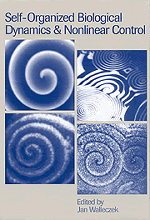 Self-Organized Biological Dynamics and Nonlinear Control
Self-Organized Biological Dynamics and Nonlinear Control Book contents
- Frontmatter
- Contents
- List of contributors
- Preface
- The frontiers and challenges of biodynamics research
- Part I Nonlinear dynamics in biology and response to stimuli
- Part II Nonlinear sensitivity of biological systems to electromagnetic stimuli
- Part III Stochastic noise-induced dynamics and transport in biological systems
- 10 Stochastic resonance: looking forward
- 11 Stochastic resonance and small-amplitude signal transduction in voltage-gated ion channels
- 12 Ratchets, rectifiers, and demons: the constructive role of noise in free energy and signal transduction
- 13 Cellular transduction of periodic and stochastic energy signals by electroconformational coupling
- Part IV Nonlinear control of biological and other excitable systems
- Index
12 - Ratchets, rectifiers, and demons: the constructive role of noise in free energy and signal transduction
Published online by Cambridge University Press: 14 August 2009
- Frontmatter
- Contents
- List of contributors
- Preface
- The frontiers and challenges of biodynamics research
- Part I Nonlinear dynamics in biology and response to stimuli
- Part II Nonlinear sensitivity of biological systems to electromagnetic stimuli
- Part III Stochastic noise-induced dynamics and transport in biological systems
- 10 Stochastic resonance: looking forward
- 11 Stochastic resonance and small-amplitude signal transduction in voltage-gated ion channels
- 12 Ratchets, rectifiers, and demons: the constructive role of noise in free energy and signal transduction
- 13 Cellular transduction of periodic and stochastic energy signals by electroconformational coupling
- Part IV Nonlinear control of biological and other excitable systems
- Index
Summary
Introduction
A particle in solution is subject to random collisions with solvent molecules, giving rise to the erratic, ‘Brownian’, motion first observed and reported by Robert Brown in 1826. This dynamic behavior was described theoretically by Langevin (1908), who hypothesized that the forces on the particle due to the solvent can be split into two components: (1) a fluctuating force that changes magnitude and direction very frequently compared to any other time scale of the system, and (2) a viscous drag force that always acts to slow the motion induced by the fluctuation term. Einstein (1906) derived a (fluctuation–dissipation) relationship between the magnitude of the fluctuation term and the viscous drag coefficient that dampens its effect. Since the strength of the fluctuation increases with temperature, the fluctuating force is often called thermal noise. If the particle is a molecule, bombardment by the solvent also allows exploration of the different molecular configurations, i.e., the arrangements of the atoms of the molecule relative to each other. Biological (and many other) macromolecules often have only a few stable configurations, called conformations, with large energy barriers separating them. Thermal noise ‘activates’ transitions over these barriers from one conformation to another. Kramers (1940) formulated a theory for thermal noise-activated transitions between different conformations based on diffusion over energy barriers (e.g., Hänggi et al., 1990).
Information
- Type
- Chapter
- Information
- Self-Organized Biological Dynamics and Nonlinear ControlToward Understanding Complexity, Chaos and Emergent Function in Living Systems, pp. 281 - 300Publisher: Cambridge University PressPrint publication year: 2000